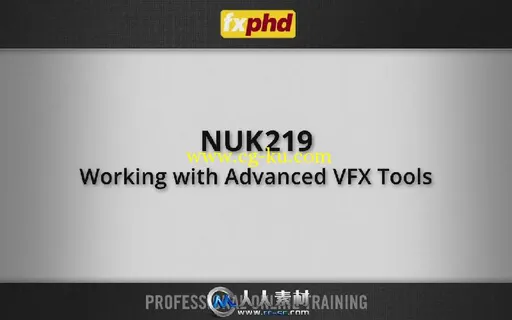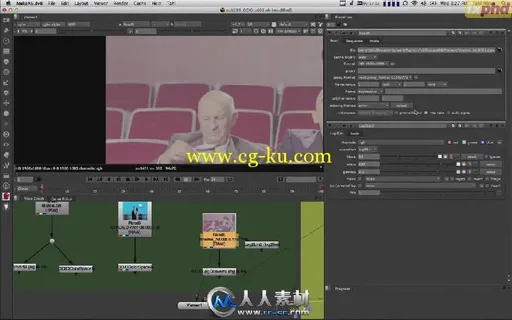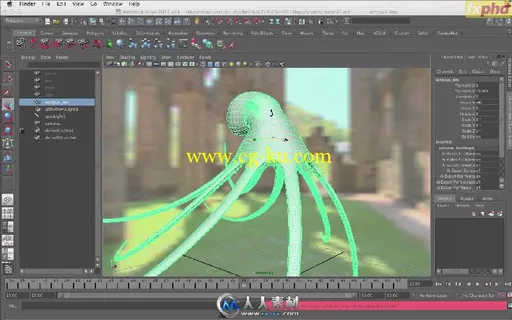本视频教程是由FXPHD机构出品的Nuke影视特效先进技术视频教程,FXPHD NUK219 Working with Advanced VFX Tools,时长:5小时47分,大小:3.84 GB,MP4高清视频格式,附工程源文件,教程使用软件:Nuke v7, Maya 2013,官方发布日期:2012年10月。语言:英语。CG数据库整理。
NUKE是一个获得学院奖(Academy Award)的数码合成软件。已经经过10年的历练,为艺术家们提供了创造具有高质素的相片效果的图像的方法。NUKE无需专门的硬件平台,但却能为艺术家提供组合和操作扫描的照片,视频板以及计算机生成的图像的灵活、有效、节约和全功能的工具。在数码领域,NUKE已被用于近百部影片和数以百计的商业和音乐电视,NUKE具有先进的将最终视觉效果与电影电视的其余部分无缝结合的能力,无论所需应用的视觉效果是什么风格或者有多复杂。Nuke合成软件参与制作的著名影视有:I, Robot 机械公敌、《极限特工》xXx、《泰坦尼克号》、T-2、《阿波罗13》、《真实的谎言》、《X战警》等...
FXPHD机构是老牌在线教学网站,网站的创建者就是Fxguide的团队,PXPHD制作了大量视觉特效、后期制作、摄影摄像的精品教程。每年支付4000元左右,就可以享受其中5门课程的教学,还可以提供VPN链接内网,每套课程都是10周左右的时间,每节课30分钟左右,包含训练文件和素材。FXPHD主打专业教学,所有的教程作者都是该领域的权威,必须拥有大量的项目经验。
FXPHD NUK219 Working with Advanced VFX Tools
Working in the trenches, artists often find it difficult to keep up with the latest changes in the industry. As part of our on going commitment to provide Core training in visual effects, we have constructed a course which will highlight some of the latest visual effects tools and techniques, enabling artists to use the most up to date software features in both the upcoming Nuke v7, Maya 2013 and the latest crop of renderers.
Go beyond the manuals and pre-canned demos to examine how new tools and technology actually work. Tahl Niran and Matt Leonard are joining forces to create a comprehensive overview of features using practical examples and some complex projects to demonstrate how to make all the applications, formats and tools work together.
This course will feature both breakdowns of the technology of advanced tools AND project based classes in which they will explain how to use these complex tool to produce quality work . A good working knowledge of both Maya and Nuke is essential for people wishing to get the most out of this class.
Tahl Niran, is a compositor and trainer who has been working in visual effects since 1999. In that time he has worked in games, broadcast design, tv commercials and feature films and trained artists in Australia, London, New York, Mumbai and Shanghai. Tahl was one of the foundation professors at FXPHD and also one of the creators of the original Foundry Nuke Masterclasses. He returns to FXPHD after three years in London working with the team at Double Negative Visual Effects.
Leonard has been in the 3D and visual effects industry for 19 years and has produced work for feature films, commercials and large corporate projects. He has spoken at various events and shows on behalf of Autodesk, The Foundry and eyeon Software and has had articles published in magazines and journals. He has worked as a beta tester for Maya, Mari, Mudbox, Nuke and Fusion. He currently runs his own on-site training company in the UK and has trained artists from companies such as Double Negative, Ghost VFX, Dreamworks Animation and Framestore.
详细章节内容:
Class syllabus:
Class 1: What is openColor IO (OCIO) ? Introduction to the use of OCIO for colour management in Nuke. Overview of OCIO nodes and concepts:linear workflow, scene referred linear, and nuke colour management.
Class 2: OCIO and texture creation. Converting log and scene linear images for text and reference. Linear workflow for IBL, Mental Ray and colour management in Maya 2013. Creating view LUTs, using OCIO CDLs and baking LUTs for Maya and integrating OCIO in Maya 2013 and Nuke.
Class 3: Choosing a render engine. Features, Image quality, and practical output options. How do you choose? We’ll cover Pixar’s RenderMan, Nvidia’s mental ray, Solid Angel’s Arnold, and Chaos Group’s V-Ray.
Class 4: Render Engines: This class we look at the differences between the four main render engines available for feature film work. RenderMan, mental ray, Arnold and V-Ray. We briefly look at the history of RenderMan and other compliant renders before moving into Maya and looking in more detail at the specific renderers.
Class 5: Render Engines for Maya and Nuke. Comparison of the same scene using Arnold, vary, prman and mental ray. Additive and subtractive compositing approaches.
Class 6: Project 1, cont. Creating 3D assets. We’ll use Maya, Mari and our selected renderer to create the 3D assets needed for our Project. Lighting rendering and breaking our 3d work into deliverables for comp
Class 7: Project 1, cont. Compositing CG assets and making it work. Colour matching, optical enhancements and integration using CG data from 3d for complex interaction.
Class 8: Project 2. Our second project is a localized HDRI project utlizing Maya, mental ray, and NUKE. We’ll be using projected images and proxy geometry to create a localized HDR Illuminated object integrate into an environment. In part 1, we’ll be creating assets for 3D, setting up HDR material for our Image Based Lighting scene. We’ll use NUKE to Create virtual sets to aid in lighting and integration.
Class 9: Project 2, Part 2. Creating 3d assets. We’ll create an IBL asset in Maya, generate output passes, and include rendering workflow tips and tricks.
Class 10: Project 2, Part 3. Compositing the Project. We’ll integrate rendered CG assets back into our scene using previously created Gizmos, use tools to add extra 3D in NUKE, and much more.



发布日期: 2013-1-8